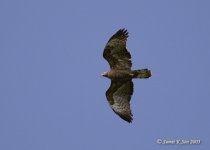Respected Sirs,
I have one number raptor from 7,000 feet in the Sikkim Himalayas, India. Seems like it is an Oriental Honey Buzzard (worried after all the stuff I read in the HB vs CB thread!!!). Seems also like it is a Siberian race migrant (female Pernis ptilorhyncus orientalis ??), which is rare for India. The learned can guide me further.
Thanks,
Sumit
I have one number raptor from 7,000 feet in the Sikkim Himalayas, India. Seems like it is an Oriental Honey Buzzard (worried after all the stuff I read in the HB vs CB thread!!!). Seems also like it is a Siberian race migrant (female Pernis ptilorhyncus orientalis ??), which is rare for India. The learned can guide me further.
Thanks,
Sumit






